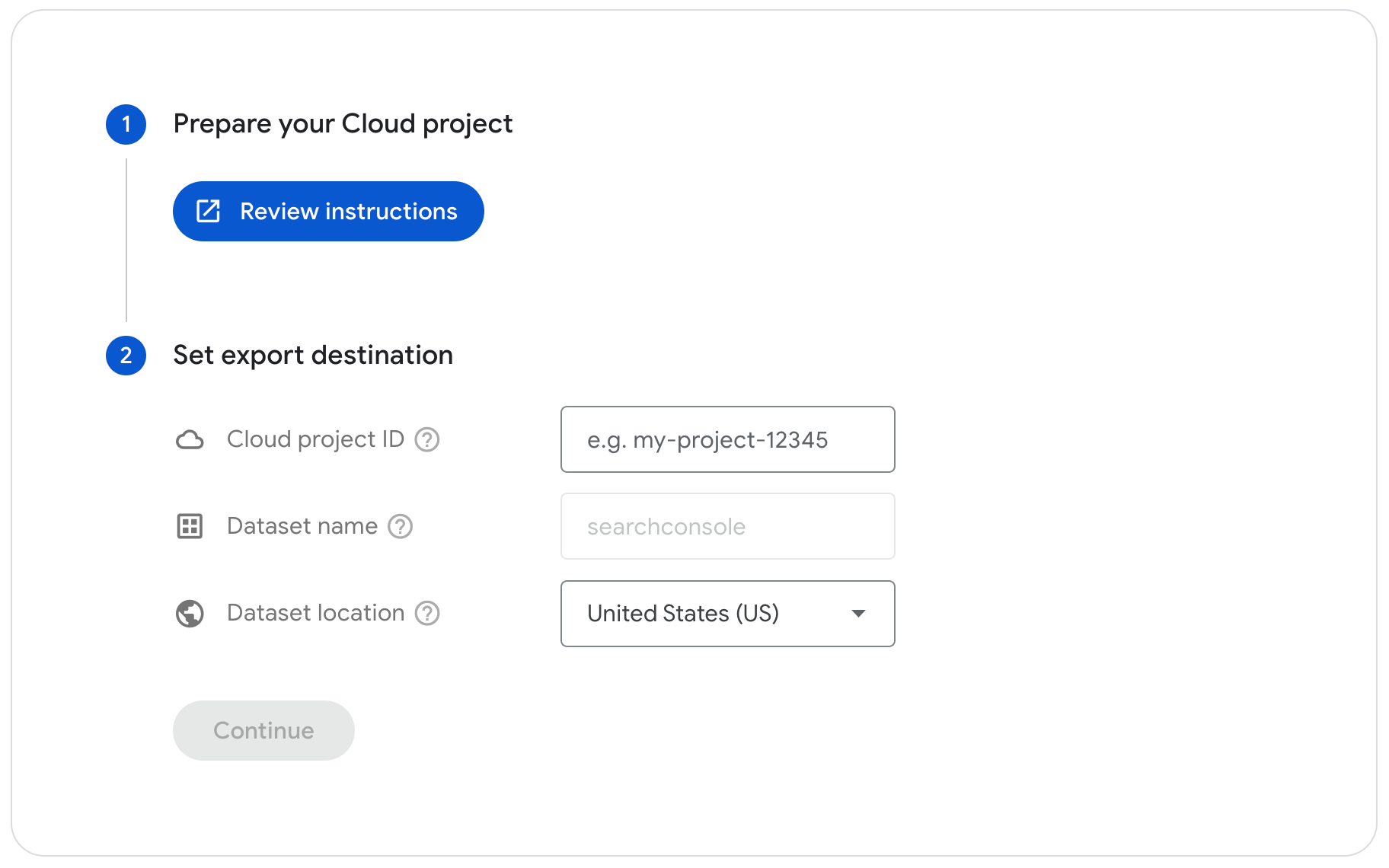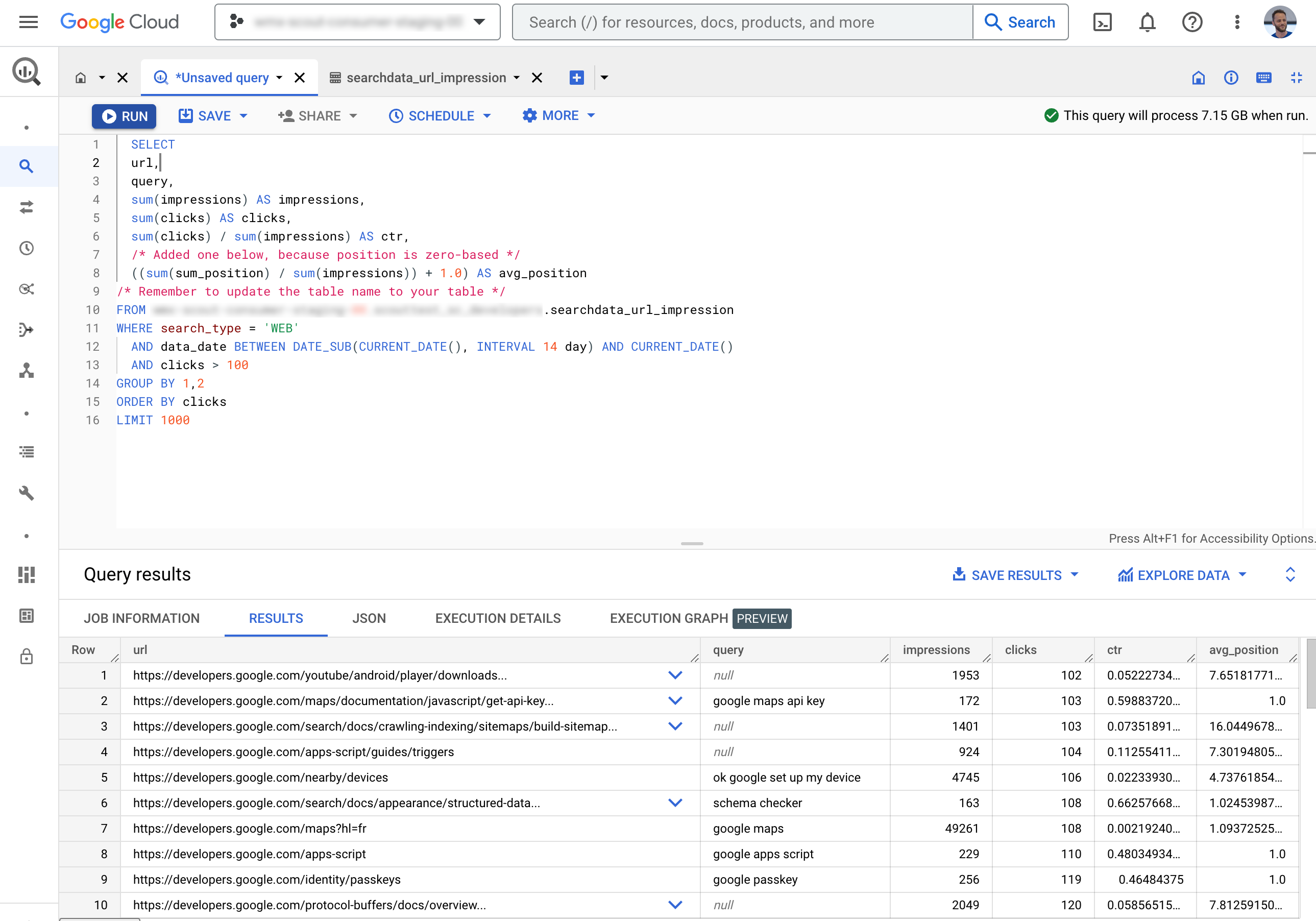批量数据导出:访问 Search Console 数据的全新强大方式
使用集合让一切井井有条
根据您的偏好保存内容并对其进行分类。
2023 年 2 月 21 日,星期二
今天,我们宣布推出批量数据导出功能。借助这项新功能,您可以将数据从 Search Console 持续导出至 Google BigQuery。(请注意,发布大约需要 1 周才能完成,因此您可能无法立即使用该功能)。
您可以在 Search Console 中配置导出,将每日数据转储导出至 BigQuery 项目。除了出于隐私保护方面的原因而被滤除的匿名化查询之外,这些数据包括您所有的效果数据;也就是说,批量数据导出不受每日数据行数上限的影响。这意味着,您可以充分发挥数据的潜力,将其与其他数据源相结合,善用高级分析和可视化图表分析法。
对于拥有成千上万个网页或每天接收来自成千上万个查询的流量(或两者皆有)的大型网站而言,此数据导出功能尤为有用。中小型网站已经能够通过界面、Looker Studio 连接器(以前称为数据洞察连接器)或 Search Analytics API 访问所有的数据。
设置新的批量数据导出
如需配置新的报告,您需要备妥 BigQuery 账号以接收数据,并在 Search Console 设置中设置所需的详细信息。请前往帮助中心查看分步指南,但一般而言,流程分为两个阶段:
- 准备 Cloud 项目(在 Google Cloud 控制台中):这包括为您的项目启用 BigQuery API,授予 Search Console 服务账号的权限。
- 设置导出目标位置(在 Search Console 中):这包括提供您的 Google Cloud 项目 ID,选择数据集位置。请注意,只有资源所有者才能设置批量数据导出。

向 Search Console 提交信息后,系统会模拟导出。如果导出成功,我们会通过电子邮件通知所有资源所有者,且您持续进行的导出将在 48 小时内开始。如果导出模拟失败,您将收到有关检测到的问题的即时警示;下面列出了可能出现的导出错误。
批量数据导出中的可用数据
成功设置批量数据导出后,您就可以登录 BigQuery 账号并开始查询数据了。
您可以在帮助中心找到详细的表格指南和参考资料;另请查看按资源汇总数据与按网页汇总数据之间的区别说明,以便更好地解读相关数据。下面简要介绍了适用于您的三种表格:
searchdata_site_impression:此表格包含按资源汇总的数据,包括查询、国家/地区、类型和设备。searchdata_url_impression:此表格包含按网址汇总的数据,可让您更详细地查看查询和富媒体搜索结果。ExportLog:此表格记录了当天保存了哪些数据。此处不会记录失败的导出。

如果您在查询数据方面需要一些帮助,请查看帮助中心内发布的示例查询,这些查询可以帮助您轻松上手使用。以下是其中一个示例,对于过去两周至少获得 100 次常见问题解答富媒体搜索结果展示次数的网页,我们会按网址组合提取总查询数。
SELECT
url,
query,
sum(impressions) AS impressions,
sum(clicks) AS clicks,
sum(clicks) / sum(impressions) AS ctr,
/* Added one below, because position is zero-based */
((sum(sum_position) / sum(impressions)) + 1.0) AS avg_position
/* Remember to update the table name to your table */
FROM searchconsole.searchdata_url_impression
WHERE search_type = 'WEB'
AND is_tpf_faq = true
AND data_date BETWEEN DATE_SUB(CURRENT_DATE(), INTERVAL 14 day) AND CURRENT_DATE()
AND clicks > 100
GROUP BY 1,2
ORDER BY clicks
LIMIT 1000
我们希望通过增加可用的 Google 搜索数据,让网站所有者和搜索引擎优化人员能够通过分析长尾查询在内容方面发掘更多机会。此外,您还可以更轻松、更有效、更全面地将来自内部系统的网页级信息添加到搜索结果中。
和往常一样,如果您有任何问题或疑虑,请通过 Google 搜索中心社区或 Twitter 联系我们。
发布者:Search Console 团队的 Daniel Waisberg、Gaal Yahas 和 Haim Daniel
如未另行说明,那么本页面中的内容已根据知识共享署名 4.0 许可获得了许可,并且代码示例已根据 Apache 2.0 许可获得了许可。有关详情,请参阅 Google 开发者网站政策。Java 是 Oracle 和/或其关联公司的注册商标。
[null,null,[],[[["\u003cp\u003eGoogle Search Console introduces a new bulk data export feature, enabling ongoing data transfer to Google BigQuery.\u003c/p\u003e\n"],["\u003cp\u003eThe export encompasses all performance data, excluding anonymized queries for privacy, and is ideal for large websites with significant traffic.\u003c/p\u003e\n"],["\u003cp\u003eSetting up the export involves preparing your BigQuery account and configuring the export destination within Search Console.\u003c/p\u003e\n"],["\u003cp\u003eThree BigQuery tables will be available: \u003ccode\u003esearchdata_site_impression\u003c/code\u003e, \u003ccode\u003esearchdata_url_impression\u003c/code\u003e, and \u003ccode\u003eExportLog\u003c/code\u003e, providing comprehensive data for analysis.\u003c/p\u003e\n"],["\u003cp\u003eThis feature empowers website owners and SEOs to discover content opportunities, analyze long-tail queries, and integrate internal data for enhanced insights.\u003c/p\u003e\n"]]],["Search Console now allows users to export data to Google BigQuery daily. This includes performance data, excluding anonymized queries. To set up, users need to prepare their Google Cloud project by enabling the BigQuery API and granting permissions. Then in Search Console, they provide their project ID and choose a dataset location. Once set up, data is accessible via three tables: `searchdata_site_impression`, `searchdata_url_impression`, and `ExportLog`. This feature suits large sites, enabling advanced data analysis.\n"],null,["# Bulk data export: a new and powerful way to access your Search Console data\n\nTuesday, February 21, 2023\n\n\nToday, we're announcing [bulk\ndata export](https://support.google.com/webmasters/answer/12918484), a new feature that allows you to export data from Search Console to\n[Google BigQuery](https://cloud.google.com/bigquery) on an ongoing basis.\n(*Note that the rollout will take approximately one week, so you may not have access right away.*)\n\n\nYou can configure an export in Search Console to get a daily data dump into your BigQuery project.\nThe data includes all your performance data, apart from anonymized queries, which are filtered out\nfor privacy reasons; in other words, the bulk data export is not affected by the\n[daily data row limit](/search/blog/2022/10/performance-data-deep-dive#daily-data-row-limit).\nThis means you can explore your data to its maximum potential, joining it with other sources of data\nand using advanced analysis and visualization techniques.\n\n\nThis data export could be particularly helpful for large websites with tens of thousands of pages, or those receiving\ntraffic from tens of thousands of queries a day (or both!). Small and medium sites already have access to all their\ndata through the user interface, the [Looker Studio connector](/search/blog/2022/03/monitoring-dashboard)\n(formerly known as Data Studio) or the [Search Analytics API](https://developers.google.com/webmaster-tools/v1/searchanalytics/query).\n\nSetting up a new bulk data export\n---------------------------------\n\n\nTo configure a new report, you'll need to prepare your BigQuery account to receive the data and set up\nyour details in the Search Console settings. Check the Help Center for a\n[step-by-step guide](https://support.google.com/webmasters/answer/12917675),\nbut in general, the process is divided into two stages:\n\n1. **Prepare your Cloud project** ([inside Google Cloud Console](https://console.cloud.google.com/)): this includes enabling the BigQuery API for your project and giving permission to your Search Console service account.\n2. **Set export destination** ([inside Search Console](https://search.google.com/search-console/settings/bulk-data-export)): this includes providing your Google Cloud project ID, and choosing a dataset location. Note that only property owners can set up a bulk data export.\n\n\nOnce you submit the information to Search Console, it'll simulate an export. If the export succeeds, we'll inform all property owners via email and your\nongoing exports will start within 48 hours. If the export simulation fails, you'll receive an immediate alert on the issue detected; here's a list of\n[possible export errors](https://support.google.com/webmasters/answer/12919198).\n\nData available on bulk data exports\n-----------------------------------\n\n\nOnce the bulk data export is set up successfully, you can log in to your BigQuery account and start querying the data.\n\n\nYou can find detailed [table guidelines and references](https://support.google.com/webmasters/answer/12917991) in the help center;\nalso check the explanation on the difference between [aggregating\ndata by property vs by page](https://support.google.com/webmasters/answer/7576553#urlorsite), as it'll help you understand the data better. Here is a quick description of the three tables that will be available to you:\n\n- `searchdata_site_impression`: This table contains data aggregated by property, including query, country, type, and device.\n- `searchdata_url_impression`: This table contains data aggregated by URL, which enables a more detailed view of queries and rich results.\n- `ExportLog`: This table is a record of what data was saved for that day. Failed exports are not recorded here.\n\n\nIf you need a little help to start querying the data, check the [sample queries](https://support.google.com/webmasters/answer/12917174)\npublished in the help center, they can be handy to get up and running. Here's one example, where we pull the total query by URL combinations for pages with at least\n100 FAQ rich result impressions over the last two weeks. \n\n```carbon\nSELECT\n url,\n query,\n sum(impressions) AS impressions,\n sum(clicks) AS clicks,\n sum(clicks) / sum(impressions) AS ctr,\n /* Added one below, because position is zero-based */\n ((sum(sum_position) / sum(impressions)) + 1.0) AS avg_position\n/* Remember to update the table name to your table */\nFROM searchconsole.searchdata_url_impression\nWHERE search_type = 'WEB'\n AND is_tpf_faq = true\n AND data_date BETWEEN DATE_SUB(CURRENT_DATE(), INTERVAL 14 day) AND CURRENT_DATE()\n AND clicks \u003e 100\nGROUP BY 1,2\nORDER BY clicks\nLIMIT 1000\n```\n\n\nWe hope that by making more Google Search data available, website owners and SEOs will be able to find more content opportunities by analyzing long tail queries.\nIt'll also make it easier to join page-level information from internal systems to Search results in a more effective and comprehensive way.\n\n\nAnd as always, if you have any questions or concerns, please reach out to us via the [Google\nSearch Central Community](https://support.google.com/webmasters/threads?thread_filter=(category:search_console)) or on [Twitter](https://twitter.com/googlesearchc).\n\nPosted by [Daniel Waisberg](https://www.danielwaisberg.com), Gaal Yahas, and Haim Daniel, Search Console team"]]


